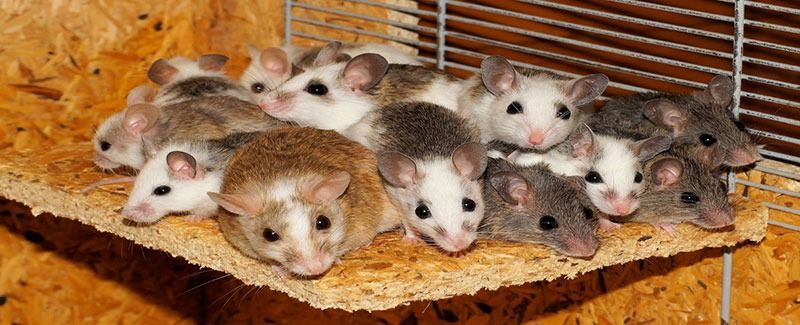About unexpected results: predator odor excites mice
The temperature of the tail and eyes of rodents is indicative of their emotional state. What would be the effect of a specific predator cue?
Posted by
Published on
Wed 15 May. 2019
Topics
| Emotions | EthoVision XT | Mice | Video Tracking |

The temperature of the tail and eyes of rodents is indicative of their emotional state. This study researches what the effect is of a specific predator cue, using a thermal camera and behavioral experiments. The result might not be what you expect.
It is not easy to determine emotions in animals, but thanks to extensive research it is now possible to reliably assess the emotional state in various species. In order to test this, scientists measured minor temperature changes in specific body parts and connected them to certain response.
Unconditioned fear
In a recent study, scientists from the Université Paris and the University of British Columbia collaborated to assess the emotional response to predator odor in rodents, using infrared thermography and behavioral research. Predator odors are often used as an unconditioned fear-inducer. Therefore, they are useful in research to short-term physiological fear response.
A thermal response to predator odor
When animals experience emotions, their body responds with blood flow regulation, causing minor body temperature changes. Therefore, infrared thermography, together with behavioral experiments, are useful in assessing emotions triggered by various treatments. In rodents, the eye and tail temperature are the most indicative.
Eye temperature and emotional states
Changes in eye temperature are linked to both positive and negative emotional states, thus suggesting arousal. Unconditioned fear is associated with an increase in eye temperature. This is explained as the body’s attempt to ensure blood support of vital body parts, like the brain and muscles used in fight or flight response.

Tail temperature decrease
When exposed to both conditioned and unconditioned fear, rodents often show a decrease in tail temperature. This prevents excessive bleeding when they get hurt, therefore increasing the chance of survival.
In this study, a decrease in tail temperature was expected, as well as an increase in eye temperature, after exposure to predator odor. A behavioral analysis was carried out as well.
Predator odor to induce unconditioned fear
In this research, a predator cue, TMT is used to induce unconditioned fear. TMT (2,5-dihydro-2,4,5-trimethylthiazole) is a predator odor component isolated from fox feces, which is used often in rodent studies on anti-predator responses.
Fear responses in naïve mice
Naïve male house mice were exposed to either TMT or water during a behavioral test. Individuals were placed in a Plexiglas open arena (36x24x60cm), and allowed to habituate for 30 minutes.
Odor exposure
After habituation, the mice were exposed to one of the treatments. Using a syringe, 1 ml of liquid was injected into a cotton ball, which was then placed inside a small plastic tube pierced at both ends. From there, flexible tubes were connected to the arena and to an air pump, through which the air was continuously pumped into the arena.
Infrared thermography
The experiments were filmed using a thermal camera, from five minutes before until five minutes after the treatment started. Each minute, three images were selected where the mouse walked straight. The maximum peripheral body temperature (a proxy of eye temperature) and tail temperature of each image were used for the analysis.
Behavioral analysis
The behavioral analysis took place during the full 10 minutes of the experiments. The researchers used Noldus Ethovision XT to analyze how much time the mice spent both close to and far away from the odor. Duration and frequency of freezing behaviors were recorded as well.
Rapid eye temperature increase
The rapid eye temperature increase that indicates arousal was found in the present study. Another research study showed similar results after predator exposure, thus indicating that eye temperature is a reliable measure of emotional state in rodents. This also indicates that TMT causes general excitement. Furthermore, mice with a higher eye temperature increase also showed a higher tail temperature increase, thus indicating that some individuals were more excited by predator cues than others.
Tail temperature suggest arousal
Various fear tests in rodents show specific physiological responses, for example stress-induced hyperthermia, decrease of tail temperature, and changes in heart rate and blood pressure. Unexpectedly, exposure to TMT caused an increase in tail temperature, suggesting general arousal, where previous studies suggested that TMT can increase heart rates and corticosterone, suggesting fear. Other studies related to stress-induced hyperthermia indicated that various physiological stress-responses can change independently.
No typical fear response
The mice showed no typical fear response after TMT treatment. They approached the predator cue, showed a notable absence of typical defensive behaviors, and they were aroused, which are all results confirmed by previous research. Furthermore, heart rate and corticosterone increases found in previous research seem to be a typical predator cue response. Those results indicate that rodents respond differently to predator cue in comparison to an actual predator, and try to collect more olfactory information.
Animal fear response varies depending on the situation
In short, TMT causes no decrease in tail temperature, which is typical during other fearful situations. Instead, it shows a short-term increase, indicating excitement. This might indicate that TMT is an indirect threatening cue. The present research and previously mentioned reports suggest that animal fear response could vary among different kinds of fearful situations, depending on the triggering cues. In order to increase understanding of responses to TMT, further research is needed to both physiological and emotional responses to the cue.
References
Lecorps, B., Rödel, H. G., & Féron, C. (2019). Short-term thermal responses after exposure to predator odor (TMT) in the house mouse. Mammalian Biology, 94, 25-29.
Related Posts

How to easily automate the elevated plus maze test

Animal research assists in understanding fentanyl withdrawal symptoms

